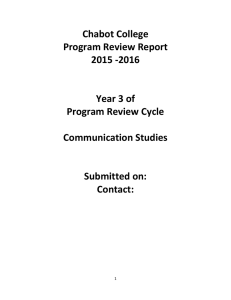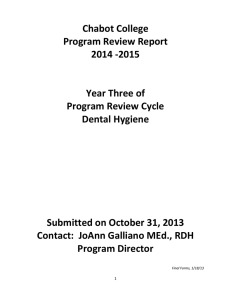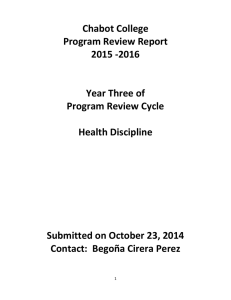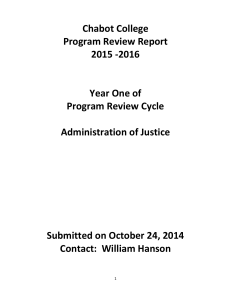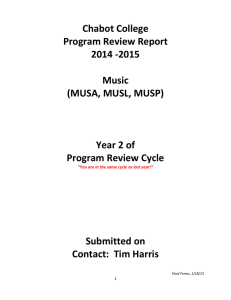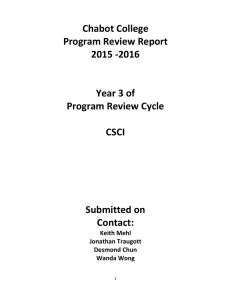Chabot College Academic Program Review Report Year Two of
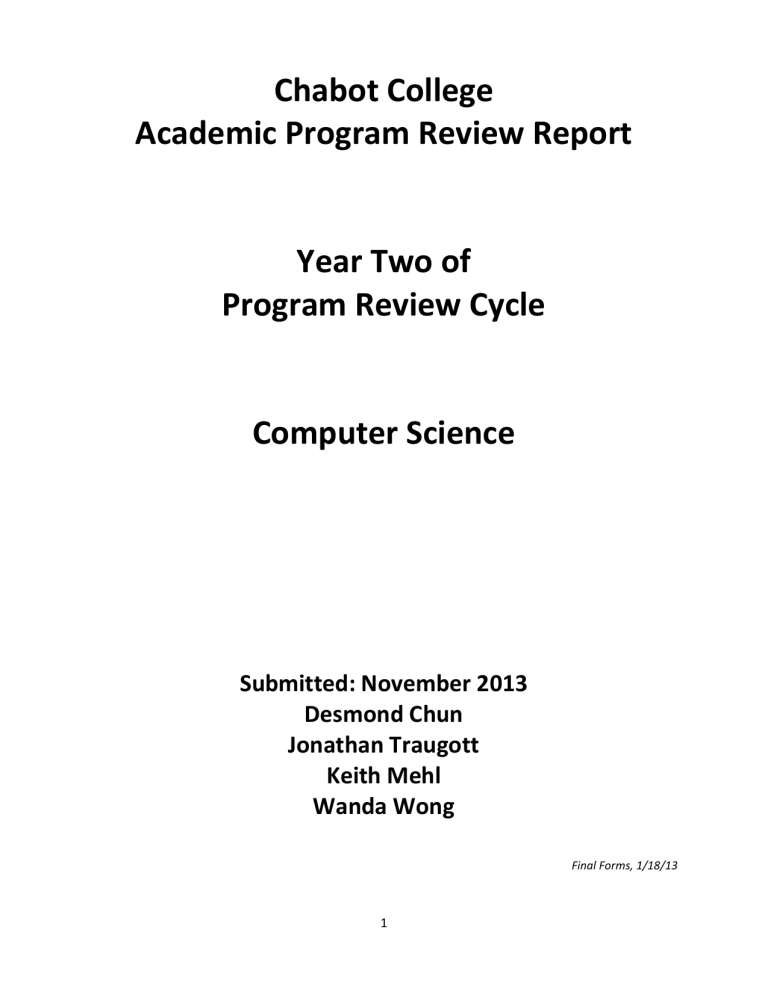
Chabot
College
Academic
Program
Review
Report
Year
Two
of
Program
Review
Cycle
Computer
Science
Submitted:
November
2013
Desmond
Chun
Jonathan
Traugott
Keith
Mehl
Wanda
Wong
Final Forms, 1/18/13
1
Appendix
B2:
“Closing
the
Loop”
Assessment
Reflections
Course
Semester assessment data gathered
Number of sections offered in the semester
Number of sections assessed
CSCI 10
Fall 2011
1
1
Percentage of sections assessed
Semester held “Closing the Loop” discussion
100%
Spring 2012
Faculty members involved in “Closing the Loop” discussion 1
Form Instructions:
Part I: CLO Data Reporting .
For each CLO, obtain Class Achievement data in aggregate for all sections assessed in eLumen.
Part II: CLO Reflections .
Based on student success reported in Part I, reflect on the individual
CLO.
Part III: Course Reflection.
In reviewing all the CLOs and your findings, reflect on the course as a whole.
P
ART
I: C
OURSE
‐ L
EVEL
O
UTCOMES
– D
ATA
R
ESULTS
C ONSIDER T HE C OURSE ‐ L EVEL O UTCOMES I NDIVIDUALLY ( THE
N UMBER OF CLO S WILL DIFFER BY COURSE
)
Defined Target
Scores*
(CLO Goal)
80% (CLO) 1:
Recognize the functionally and ease of windows based user interface (IDE) for programs written in Visual
Basic.NET
by selecting and understanding which of the proper or available objects controls to embed on the Form and to code the proper event that each of those objects
"detect" when the program is executing.
Discuss the
advantages of a window based, event driven language vs.
an older "command line prompt language such as C or C++.
(CLO) 2:
Using and concept of loops (i.e.
for and while).
When is a
loop appropriate to the logic and which particular type of loop is best to use in that situation.
(CLO) 3:
Use of graphics, sound, mouse and timer based capabilities within a Visual Basic application
(CLO) 4:
80%
75%
Actual Scores**
(eLumen data)
85%
75%
85%
2
If more CLOs are listed for the course, add another row to the table.
* Defined Target Scores :What scores in eLumen from your students would indicate success for this CLO?
(Example: 75% of the class scored either 3 or 4)
**Actual scores: What is the actual percent of students that meet defined target based on the eLumen data collected in this assessment cycle?
P
ART
II: C
OURSE
‐
LEVEL
O
UTCOME
R
EFLECTIONS
A.
C OURSE ‐ L EVEL O UTCOME (CLO) 1:
1.
How do your current scores match with your above target for student success in this course level outcome?
Windows based programming requires a higher degree of skill and knowledge since it is a more complex application.
Most students have an affinity to this newer programming
language and its capabilities vs.
the more arcane older language’s grammar and syntax
2.
Reflection: Based on the data gathered, and considering your teaching experiences and your discussions with other faculty, what reflections and insights do you have?
Since CSCI 6, CSCI 10 and CSCI 19A are not in the transfer core, they are in a strict sense non ‐ essential courses.
This perspective is useful but we need to temper it with real ‐ world considerations.
In a work environment, job candidates often fail since that situation or application tools do not match what was in the class room or textbook.
Different languages, their capabilities and syntax give that student the breath of a wider world.
Similarly in the transfer school, a student who has not been exposed to a variety of programming languages is unable to pick up new ones quickly.
For example if the student transfers to San Jose State they may need to quickly pick up the Java programing language.
Without having taken some non C++ based course they will find the transition difficult if not impossible.
So while it may be productive to reallocate some FTEF from non ‐ transfer course to transfer courses, it would be counterproductive to do so in excess or to simply regard the
non ‐ transfer courses as expendable.
B.
C
OURSE
‐ L
EVEL
O
UTCOME
(CLO)
2:
1.
How do your current scores match with your above target for student success in this course level outcome?
About as expected.
You tend to see a very good student or a student who is struggling.
Rarely do you find a real “average” in the middle type.
2.
Reflection: Based on the data gathered, and considering your teaching experiences and your discussions with other faculty, what reflections and insights do you have?
3
It is the preparation, discipline, dedication and background of the general population.
The older, experienced ones who have been in industry tend to do far better than the
ones just out of high school.
That is something out of our control.
The better students have gone directly to a four year institution and bypassed the CC system.
The less prepared seem to have no inkling of what is required or the personal cost and dedication to be a Computer Science major.
We need to do a better job of informing new students
about the commitments required to succeed as a Computer Science major.
C.
C OURSE ‐ L EVEL O UTCOME (CLO) 3:
1.
How do your current scores match with your above target for student success in this course level outcome?
The students who use the current smart devices have an affinity and interests in this capability as they can relate to it.
Students wonder “how is this relevant” when offered the old style command ‐ line interface of C++.
CSCI 6, CSCI 10 and CSCI 19A offer a more contemporary graphical style of programming so they provide good complements to the core transfer courses taught in C++.
2.
Reflection: Based on the data gathered, and considering your teaching experiences and
your discussions with other faculty, what reflections and insights do you have?
Students benefit from this type of 21 st century application programming language.
But
unless motivated to do so, many individuals do not explore for curiosity’s sake.
D.
C
OURSE
‐ L
EVEL
O
UTCOME
(CLO)
4:
1.
How do your current scores match with your above target for student success in this course level outcome?
N/A
2.
Reflection: Based on the data gathered, and considering your teaching experiences and your discussions with other faculty, what reflections and insights do you have?
4
E.
C OURSE ‐ L EVEL O UTCOME (CLO) 5: A DD IF NEEDED .
5
P
ART
III: C
OURSE
R
EFLECTIONS
AND
F
UTURE
P
LANS
1.
What changes were made to your course based on the previous assessment cycle, the prior
Closing the Loop reflections and other faculty discussions?
In order to work within limited FTEF we are looking to Chabot Community Ed.
to offer courses of a more vocational nature.
One such course will be offered this summer in
Android smart phone Programming .
2.
Based on the current assessment and reflections, what course ‐ level and programmatic strengths have the assessment reflections revealed?
What actions has your discipline determined might be taken as a result of your reflections, discussions, and insights?
Reallocating some FTEF from the non ‐ core courses to the transfer sequence.
But just shuffling courses is a long term solution.
We hope additional FTEF will be available in coming
years to support growth of the program.
3.
What is the nature of the planned actions (please check all that apply)?
Curricular
Pedagogical
Resource based
Change to CLO or rubric
Change to assessment methods
Other:___ None of the above _______________________________________
6
Appendix
C:
Program
Learning
Outcomes
Considering your feedback, findings, and/or information that has arisen from the course level discussions, please reflect on each of your Program Level Outcomes.
Program: __Computer Science______________________________________________
PLO #1: Transfer preparation : Prepare students for transfer to a four year college and successful completion of upper division courses in Computer Science.
This PLO primarily involves the course sequence CSCI 7, CSCI 14, CSCI 15, CSCI 20, CSCI 21 and secondarily CSCI 10, CSCI 19A and CSCI 41.
Produce a transfer ready Computer Science major that has a very solid foundation to succeed at the Junior and Senior level.
This is manifested by the eLumen SLOs for each of our courses.
PLO #2: Programming Fluency : Logical thinking and standard methodology to determine a logical solution or process.
What factors in the assignment or task govern your use of various options within the language?
Cover the major standard capabilities in the programming language such as arrays, looping, decision making structures, input/output, data file processing and manipulations, memory pointers and sorting, for example.
The PLO relates to all programming courses.
Get the students through the program as quickly and efficiently as possible and provide them with as wide a range of languages as possible (i.e.
UNIX environment, basic Microsoft
Windows, Microsoft Office Suite, C/C++, Python, Visual Basic, Java for example).
We no longer teach HTML or any web based capabilities in a web based world.
What questions or investigations arose as a result of these reflections or discussions?
A student is transfer ready only if that have taken the core transfer sequence (CSCI 14, 15, 20,
21) AND been exposed to at least two other high level programming languages besides C++, for
example Java in CSCI 19A and Python in CSCI 7.
What program ‐ level strengths have the assessment reflections revealed?
Strengths revealed: We produce a number of students that seem to do well in their transfer but that is by word of mouth and cannot be proven due to privacy laws and lack of information/data.
Reports from CSUEB indicate that our students do quite well in the
Computer Science major.
What actions has your discipline determined might be taken to enhance the learning of students completing your program?
Actions planned: Provide learning assistants for the lab component of classes.
7
